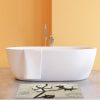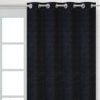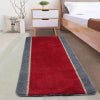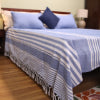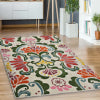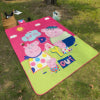Cotton vs. Cotton Blends: What's the Difference?
Posted by AMIT KUMAR

When choosing fabrics for your home or wardrobe, it is essential to understand the difference between cotton and cotton blend fabrics . Both have unique characteristics that cater to various needs and preferences. Let's delve into what sets them apart and how to make the best choice for your lifestyle.
What is Cotton?
Cotton is a natural fiber harvested from the seeds of the cotton plant. Renowned for its softness, breathability, and absorbency, cotton has been a staple in textiles for centuries. Its natural composition makes it hypoallergenic, ideal for those with sensitive skin. However, pure cotton fabrics can wrinkle easily and may require more care to maintain their appearance.
What is a Cotton Blend?
A cotton blend combines cotton with other fibers, such as polyester, spandex, or rayon, to enhance specific qualities. For instance, blending cotton with polyester can increase durability and wrinkle resistance, while adding spandex introduces stretchability. These blends aim to retain the comfort of cotton while improving functionality and often come at a more affordable price point.
Types of Cotton Blends
Different cotton blend fabrics cater to various needs. Some common blends include:
- Cotton-Polyester Blend – More durable, wrinkle-resistant, and shrink-resistant than pure cotton.
- Cotton-Spandex Blend – Provides flexibility and stretch, commonly used in activewear.
- Cotton-Rayon Blend – Offers a silky feel while maintaining cotton’s breathability.
- Cotton-Linen Blend – Combines the durability of linen with the softness of cotton, ideal for summer wear and home decor.
Cotton vs. Cotton Blend: Key Differences
|
Aspect |
Cotton |
Cotton Blend |
|
Composition |
Made from 100% natural cotton fibers. |
Contains a mix of cotton and other fibers, typically synthetic, to enhance certain properties. |
|
Durability |
While soft and comfortable, pure cotton can be prone to wear and may shrink if not properly cared for. |
The inclusion of synthetic fibers often results in increased strength, wrinkle resistance, and longevity. |
|
Breathability |
Highly breathable, making it ideal for warm climates and activewear. |
Breathability varies depending on the blended fibers; some blends may trap heat more than pure cotton. |
|
Softness |
Known for its natural softness and comfort against the skin. |
Softness can vary; some blends maintain a soft feel, while others might feel different due to the synthetic fibers. |
|
Cost |
Generally more expensive due to the natural cultivation and processing involved. |
Often more affordable, as synthetic fibers can reduce production costs. |
|
Shrinkage |
Cotton is Prone to shrinking when exposed to high temperatures during washing or drying. |
Less likely to shrink, thanks to the stability provided by synthetic fibers. |
|
Versatility |
Suitable for a wide range of products, from clothing to home textiles. |
Offers enhanced versatility, catering to specific needs like stretchability. |
Pros and Cons of Cotton vs. Cotton Blends
Pros of Cotton
✔ Soft, breathable, and hypoallergenic ✔ Absorbs moisture, keeping you cool ✔ Natural and eco-friendly options available
Cons of Cotton
✖ Prone to wrinkles ✖ Can shrink after washing ✖ Requires more maintenance
Pros of Cotton Blends
✔ More durable and long-lasting ✔ Wrinkle-resistant and easy to maintain ✔ Often more affordable than pure cotton
Cons of Cotton Blends
✖ It may not be as breathable as 100% cotton ✖ Some blends may trap heat and feel synthetic ✖ Less moisture absorption
Choosing the Right Material for Bedsheets
When selecting the best fabric for your bedsheets, consider the following:
- Climate – If you live in a warm climate, 100% cotton is better for breathability. Cotton-polyester blends work well in cooler climates.
- Comfort Preference – If you love a soft, luxurious feel, Egyptian or Pima cotton is ideal. For a smooth yet affordable option, go for a cotton blend.
- Maintenance – If you prefer low-maintenance sheets, a cotton blend is a better choice as it resists wrinkles and shrinkage.
- Budget – Pure cotton, especially high-quality variants, is more expensive than cotton blends.
Why Choose Saral Home?
At Saral Home, we understand the importance of selecting the right fabric for your home essentials. Our extensive range of products caters to diverse preferences and needs:
- Quality Materials : We offer both pure cotton and thoughtfully crafted cotton-blend items, ensuring you find the perfect match for comfort and functionality.
- Variety : From soft, breathable bed sheets to durable, easy-care mats and curtains, our collection encompasses a wide array of home furnishings.
- Affordability : We believe in providing high-quality products at competitive prices, making it easier for you to create a comfortable and stylish home.
Explore our bedsheet collection today and discover how Saral Home can enhance your living spaces with the perfect blend of comfort and style .
Key Takeaways
- Cotton is breathable, soft, and natural, while cotton blends offer durability, wrinkle resistance, and affordability.
- Cotton bedsheets provide superior comfort, while blends require less maintenance.
- Choose based on climate, comfort, and budget for the best sleep experience.
- Saral Home offers premium cotton and cotton blend home furnishings for every need.
Ready to transform your home with the perfect fabrics? Visit Saral Home's online store today and find the ideal cotton-based or cotton blend products like bedsheets, bed covers, curtains, cushion covers, sofa covers and many more.























